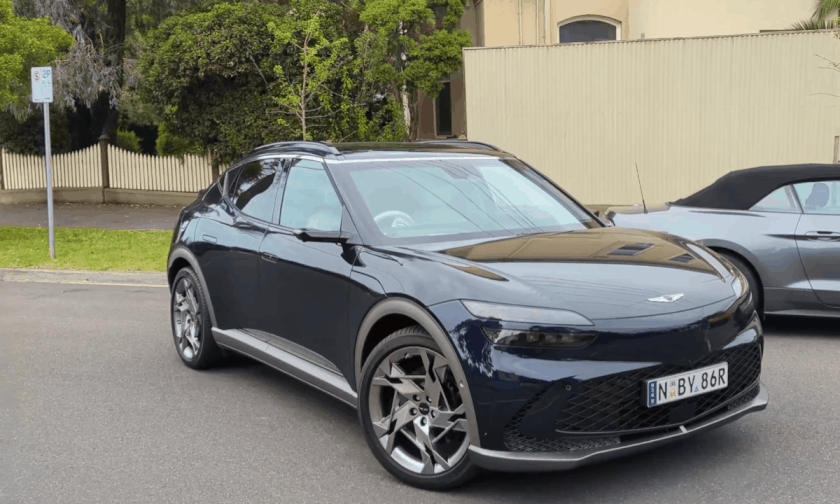Can This EV Park Better Than You? Genesis GV60’s Remote Parking Trick Tested

[ad_1]

When it comes to assisted parking, modern vehicles, especially in the premium segments, offer more than just parking sensors and rear-view cameras. We recently had the opportunity to test the remote parking feature of the Genesis GV60 AWD Performance in Australia. Spending time behind the wheel, we explored various real-life scenarios to determine whether this feature is worth having.
window.ramp.que.push(function () {
window.ramp.addTag(“pwMobiMedRectAtf”);
})
The fully electric GV60 comes standard with the “Smart Parking Assist,” a feature also available in other models of the Korean brand. This system enables the EV to navigate perpendicular or parallel parking spaces with minimal input from the user.
Notably, the driver does not need to be inside the vehicle during the parking process. Similar remote parking systems are gradually becoming available in various models from different automakers, offering a glimpse into the autonomous future.
More: Ford To Ditch Features You Don’t Use Like Auto Park
advertisement scroll to continue
window.ramp.que.push(function () {
window.ramp.addTag(‘pwDeskMedRectAtf’);
})
window.ramp.que.push(function () {
window.ramp.addTag(“pwMobiMedRectBtf1”);
})
I’ll admit that initiating the “Smart Parking Assist” could be more intuitive, as I couldn’t figure it out without reading any instructions. Thankfully, Genesis has uploaded a 3-minute-long video guide on YouTube that makes you an assisted parking expert at no time.
To activate the system, you need to press and hold the “parking view” button on the center console and then drive slowly until the vehicle identifies a suitable spot. In most instances, the GV60‘s sensors accurately detected whether the parking space was perpendicular or parallel based on the surrounding cars’ positions.
However, the vehicle cannot discern ramps or interpret parking-related signs, so human intervention is necessary to select and confirm the correct spot. Additionally, the system cannot park at an angle, although this is a maneuver that most drivers can easily manage on their own.
When you select the desired spot, you have two options – stay inside (Smart Parking) or step outside (Remote Parking). In the first case you press and hold the same “parking view” button and let the car take over the steering and the pedals until it is parked. For the second and fancier option, you put the vehicle in park, and step outside with the key. After all doors are closed, you press and hold one of the arrow buttons on the key, and the EV slowly navigates to the target position.
window._taboola = window._taboola || [];
_taboola.push({
mode: ‘thumbnails-a-mid’,
container: ‘taboola-mid-article’,
placement: ‘Mid Article’,
target_type: ‘mix’
});
window._taboola = window._taboola || [];
_taboola.push({
mode: ‘thumbnails-oc-2×1’,
container: ‘taboola-mid-article-thumbnails-organic’,
placement: ‘Mid Article Thumbnails Organic’,
target_type: ‘mix’
});
More: VW’s Software Firm And Bosch Working On Robot Tech To Park And Charge Your Car
The slow speed and steering movements are likely intentional, designed to allow people to build trust in the computer handling their precious car. In any case, if the vehicle detects an obstacle or a moving person in its path, it automatically stops. The same occurs if the user stops holding the button, pausing the parking process for whatever reason.
Last but not least, there is also the option of remotely navigating the EV out of a perpendicular parking space, with the Genesis behaving like a full-size R/C car. This is beneficial when you have parked in tight spaces and need extra room to open the doors or load the boot with large items. The process is a bit more complicated as you have to approach the car, lock the doors, press and hold the remote start button, and then press and hold the front or rear-facing arrow depending on the direction you want the car to move.
Again, this happens slowly, with the car automatically stopping if an obstacle is detected. Once you’re happy with the position you lift your finger from the button and the Genesis GV60 comes to a full stop allowing you to comfortably enter.
window.ramp.que.push(function () {
window.ramp.addTag(“pwMobiMedRectBtf2”);
})
So, what’s the verdict?
In my experience, Genesis’s “Smart Park Assist” proved to be a very effective and reliable autonomous parking system without major flaws. The only thing that hurts its usability is that the computer is inevitably slower than a human driver. I often found myself parking in the traditional way when I was in a hurry or in busy roads where other drivers were waiting behind me.
advertisement scroll to continue
window.ramp.que.push(function () {
window.ramp.addTag(“pwDeskMedRectBtf1”);
})
On the other hand, the remote parking feature is a cool way to show off to your friends and family, and can make life easier for drivers who don’t feel confident with parallel parking.
Another aspect that didn’t quite win me over is the need to press and hold the small arrow buttons for an extended period. While it does offer a sense of ultimate control over the vehicle’s movements, it can be taxing on your finger. Perhaps Genesis designers could explore ways to streamline the process in a future update, with fewer steps and shorter clicks.
Nevertheless, driver assistance systems like this play a crucial role in building public trust in autonomous vehicles, showcasing the reliability of sophisticated sensors and computing power.
Photos and Videos: Thanos Pappas for CarScoops
[ad_2]